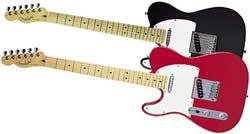 Electric Guitar. Made by Fender.
Electric Guitar. Made by Fender.No other guitar can match it -- the Fender Stratocaster is where the great guitar tradition began and still carries on today!
Featuring a fast-action maple neck, comfort-contoured body, three single-coil pickups and standard synchronized tremolo, the Fender Standard Strat is the guitarist's guitar! Pick one up and you hold the whole history of rock and roll in your hands...
Features
- BODY Alder
- NECK Maple, Modern "C" Shape, (Satin Polyurethane Finish)
- MACHINE HEADS Fender/Ping Standard Cast/Sealed Tuning Machines
- FINGERBOARD Maple, 9.5" Radius (241 mm)
- NO. OF FRETS 21 Medium Jumbo Vintage Style Frets
- PICKUPS 3 Standard Single-Coil Strat Pickups (Ceramic Magnets)
- CONTROLS Master Volume, Tone 1. (Neck Pickup), Tone 2. (Middle Pickup)
- BRIDGE Vintage Style Synchronized Tremolo
- PICKUP SWITCHING 5-Position Blade: Position 1. Bridge Pickup, Position 2. Bridge and Middle Pickup, Position 3. Middle Pickup, Position 4. Middle and Neck Pickup, Position 5. Neck Pickup
- HARDWARE Chrome
- STRINGS Fender Super Bullet 3250L, Nickel Plated Steel, (.009 to .042)
- PICKGUARD 3-Ply White
- SCALE LENGTH 25.5" (648 mm)
- WIDTH AT NUT 1.650" (42 mm)
- UNIQUE FEATURES Vintage Styling
- ACCESSORIES Includes Fender Gig Bag
NOTE: The picture on this page shows a gutiar with a Rosewood neck, if you order from this page you will receive this same model guitar with a Maple neck
One guitarist, who has been playing for about thirty years
and has used a myriad number of guitars, loves his Fender
62 reissue Telecaster, which he bought in the UK. Designed
in 1983, this Fender 62 reissue Telecaster is a very
different color of cherry grain and lighter than a Les
Paul, which he likes.
As a guitarist who dabbles in country, rock and roll and
even blues, he appreciates that the Fender 62 reissue
Telecaster is a great instrument for all three. When
playing country music he uses the pickup of the bridge; for
blues the neck pickup. A Roland processor and two twins
operating in stereo is how he started out using his Fender
62 Telecaster, but lately he employs an Ibanez compressor
with a Fender Hot Rod, 40 watt, and straight out of the
amplifier.
The only negative thing this experienced guitarist has to
say about his classic Fender 62 is that the factory vintage
tuners make it difficult to change strings very quickly.
The 62 reissue Telecaster earned a ten (out of 10) for
reliability and durability from this reviewer. He has never
had to call on customer service for any repair or support.
This accomplished musician calls his Fender 62 Telecaster
the best musical investment he has ever made.
Another guitarist, who has owned his 62 reissue Telecaster
for twenty years, said the same thing about reliability. He
has just never had a problem with it and is interested in
finding out just how long it's going to last. While he says
it's the Jeep and not the Ferrari of guitars he truly loves
the sound and action of this instrument. One negative note
from this reviewer - the strings break often.
Read more fender guitar reviews plus Martin, Gibson, and tips and info.
Want more reissued classics try the 1954 reissue Fender guitar
fender 40th anniversary stratocaster

